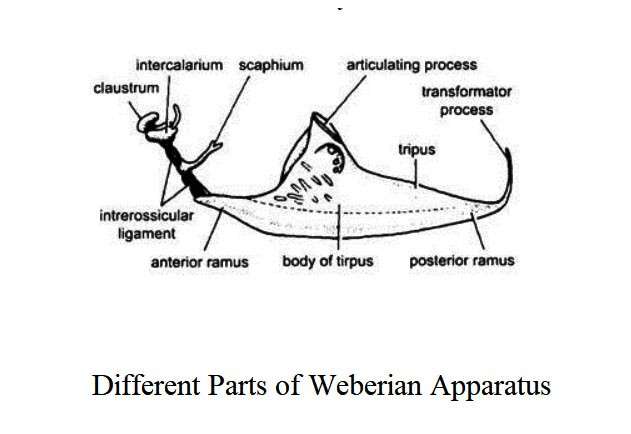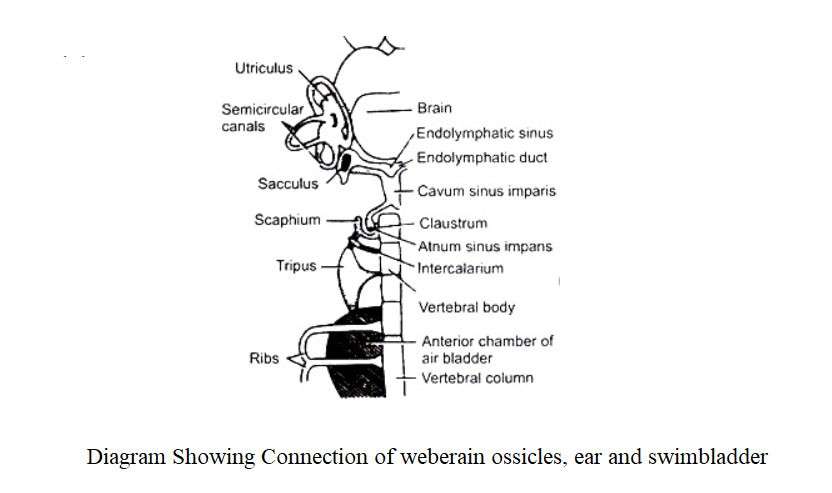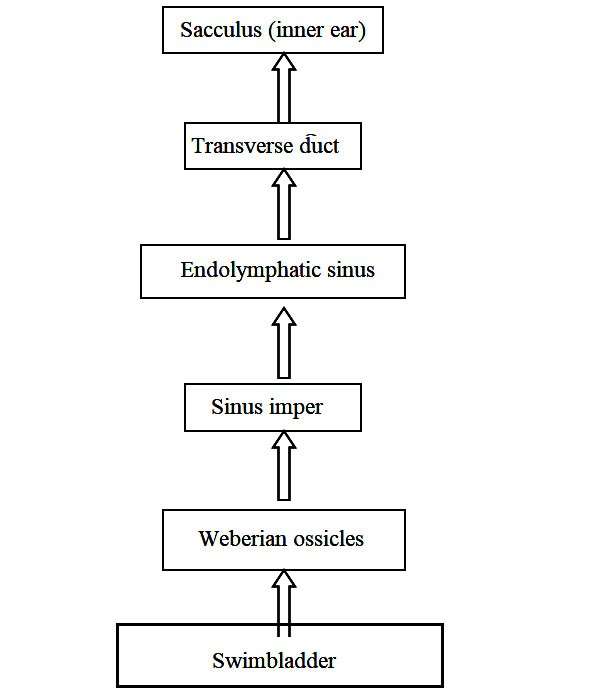The skeletal chain formed by the four ossicles connecting the anterior chamber of the perilymphatic sac and the swimbladder, known as the Weberian apparatus. Scientist Weber discovered them in 1820, hence the name Weberian Apparatus.
The bones are the tripus, the claustrum, the intercalarium, and the scaphium. Of these, the tripus, intercalarium, and scaphium are involved in the chain formation, but the 4th bone, the claustrum, is located at the apex of the scaphium. This is the smallest bone located in the front of other three bones. The claustrum participates in the formation of chains or forms part of the first vertebral neural arch.
The Weberian apparatus is found in the fish belonging to the order Cypriniformes, Characiformes, Siluriformes, and Gymnotiformes. It is the hearing and balance system of fish.
The claustrum is located on the surface of the scaphium and connects with the posterior part of the perilymphatic sac. The second bone, or scaphium, is slightly larger, wider, and compressed. It has a ventral nail-like structure that is attached to the centrum of first vertebra and is also connected to the intercalarium through the inter-ossicular ligament.
The size of the intercalarium changes as it develops. In siluroid fish (Wallagao attu, Mystus seenghala) it is a nodule of ligament bone but has no connection with the spine of vertebral column but in carp (Labeo, Cirrhina cirrhosus and Tor tor) it has a rod-like structure and extends to the centrum of the second vertebra.
The small-sized bone that exists in the joints between the scaphium and the tripus is called the intercallarium. One end of the intercalarium is bifurcated and it is connected to the tripus by another ligament. This bone carries a backward spine. The vertebral centrums of the second and third vertebrae are joined together to form a flat triangle structure on each side, known as the tripus. It consists of three outgrowths. The anterior outgrowth (anterior process) connects the inter-ossicular ligament but the meddle growth(articulating process) connects the second and third vertebrae and the posterior growth (transformator process) is large and slightly curved which is known as the modifier. It is attached to the wall of swimbladder.
Connection of Weberian Apparatus with the Ear and Swimbladder
The connection of the swimbladder and the ear via the Weberian ossicle is roughly the same in most fish species. The right and left sacculi of the membranous labyrinth are connected by a fluid filled transverse duct. A closed diverticulum from the middle of this duct meets the sinus endolymphaticus posteriorly in a fluid filled cavity called the sinus imper. In this cavity, a small diverticulum, called the perilymph fluid filled atrium sinus imper lies between the claustrum and the scaphium.
Fig. Showing Flow diagram of connection with swimbladder, ear and weberian ossicle
Functions of Weberian Apparatus
The Weberian apparatus performs the following functions by connecting the swimbladder and the ear as follows:
1. According to Bridge and Haddon (1893), Weberian ossicles act as a stress inhibitor. It is very sensitive to changes in the volume of the swimbladder due to variations in the buoyant pressure. Any change in the volume of the pelvis causes the ossicles to perform changes in the fluid pressure of the sinus imper. It then travels to the sacculus through the endolymph of the transverse duct.
In this way, the swimbladder of fish becomes more sensitive to volume change and can control the volume of the gas through pneumatic ducts. Dijkgraaf (1950) confirmed that fish can detect slight pressure changes through the Weberian oscicles, which controls the release of gas through pneumatic ducts. The ossicles perform a buoyant function by controlling the proper size of the swimbladder (Jones and Marshall, 1956).
2. The Weberian apparatus also acts as a barometer. It is thought that fish can detect variations in atmospheric pressure, so it can receive warning signals about impending climate change. Although some fish, such as Loaches (Cobitidae), are thought to be sensitive to changes in atmospheric pressure, experiments have not been able to confirm this.
3. According to Von Frisch (1932, 1936) and others, the Weberian apparatus does function on hearing. These apparatus carries the vibrations of the pelvic wall to the perilymph of the sinus imper, then through the endolymph to the saccular otoliths, which have been specially adapted to receive these vibrations. According to Von Frisch and Stetter, fish whose ears are connected to the air sac are more sensitive to high-frequency noise than those that do not.
4. According to Evans (1925), Weberian ossicles help fish to localize words. The vibrations at the source closest to the air sac or swimbladder are stronger than on the other side. However, the saccular otoliths on both sides are connected to the imper by a transverse duct that connects both chains of the Weberian ossicle. The vibrations are equally accepted via both otoliths.
Various Opinions About the Origin of Weberian Ossicles
There are various theories as to the origin of the Weberian ossicles. According to De Beer (1937) and Watson (1939), the first three vertebrae are transformed into these. The claustrum is called the modified inter-spine ossicle (Sorenson 1894) or modified spine of the first vertebra (Wright, 1964) or the first vertebral modified neural arch (Goodrich, 1909).
The scaphium is considered to be the first vertebral modified neural arch (Wright, 1974) or the first vertebral modified scapula (Goodrich, 1909). The intercalarium is formed from the second vertebral neural arch and transverse process (Bridge and Hadden 1893 1893). The tripus is made up of ribs and bony ligaments of the third vertebra (Serenson 1894). The third vertebra is formed from the transverse process and the 3rd and 4th vertebrae are formed from the scapula (Hora 1922).



